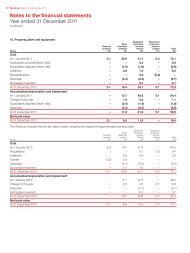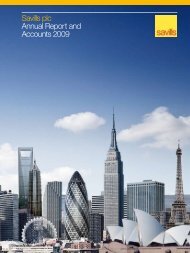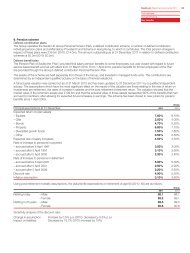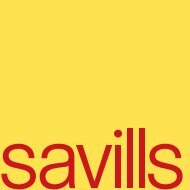Savills plc 2012 Annual Report - (PDF) - Investor relations
Savills plc 2012 Annual Report - (PDF) - Investor relations
Savills plc 2012 Annual Report - (PDF) - Investor relations
Create successful ePaper yourself
Turn your PDF publications into a flip-book with our unique Google optimized e-Paper software.
<strong>Savills</strong> <strong>plc</strong> is not subject to any externally imposed capitalrequirements, with the exception of its FSA regulated entities,which complied with all capital requirements during the yearended 31 December <strong>2012</strong>. For more information on FSA capitaladequacy requirements, please visit www.cordeasavills.com.In order to maintain an optimal capital structure, the Group mayadjust the amount of dividends paid to shareholders, return capitalto shareholders, issue new shares or sell assets to reduce debt.The Board has put in place a distribution policy which takes intoaccount the degree of maintainability of <strong>Savills</strong> different profitstreams and the Group’s overall exposure to cyclical TransactionAdvisory profits, as well as the requirement to maintain a certainlevel of cash resources for working capital and corporatedevelopment purposes. The Board will recommend an ordinarydividend broadly reflecting the profits derived from the Group’sless volatile businesses. In addition, when profits from the cyclicalTransaction Advisory business are strong, the Board will considerand, if appropriate, recommend the payment of a supplementaldividend alongside the final ordinary dividend. The value ofany such supplemental dividend will vary depending on theperformance of the Group’s Transaction Advisory businessand the Group’s anticipated working capital and corporatedevelopment requirements through the cycle. It is intended that,in normal circumstances, the combined value of the ordinaryand supplemental dividends declared in respect of any year arecovered at least 1.5 times by statutory retained earnings and/orat least 2.0 times by underlying profits after taxation.The Group’s policy is to borrow centrally if required to meetanticipated funding requirements. These borrowings, together withcash generated from operations, are then on-lent or contributedas equity to certain subsidiaries. The Board of Directors monitorsa number of debt measures on a rolling forward 12 month basisincluding gross cash by location; gross debt by location; cashsubject to restrictions; total debt servicing cost to operating profit;gross borrowings as a percentage of EBITDA (earnings beforeinterest, tax, depreciation and amortisation); and forecastheadroom against available facilities. These internal measuresindicate the levels of debt that the Group has and are closelymonitored to ensure compliance with banking covenants and toconfirm that the Group has sufficient unused facilities.The capital structure is as follows:GroupCompany£m <strong>2012</strong> 2011 <strong>2012</strong> 2011Equity 233.1 204.4 123.1 144.6Cash and cashequivalents 92.8 80.0 21.2 15.8Bank overdrafts (0.1) (1.2) – –Borrowings (1.1) (5.2) – –Net cash 91.6 73.6 21.2 15.8Fair value estimationThe following table presents the Group’s assets and liabilities thatare measured at fair value at 31 December <strong>2012</strong>:£m Level 1 Level 2 Level 3 Total<strong>2012</strong>AssetsAvailable-for-sale investments– Unlisted – 15.0 – 15.0Total assets – 15.0 – 15.0LiabilitiesDerivative financial instruments – 0.1 – 0.1Total liabilities – 0.1 – 0.1The following table presents the Group’s assets and liabilities thatare measured at fair value at 31 December 2011:£m Level 1 Level 2 Level 3 Total2011AssetsAvailable-for-sale investments– Unlisted – 14.4 – 14.4Derivative financial instruments – 0.1 – 0.1Total assets – 14.5 – 14.5LiabilitiesDerivative financial instruments – 0.1 – 0.1Total liabilities – 0.1 – 0.1The fair value of unlisted available-for-sale investments isdetermined using valuation techniques using observable marketdata where available and rely as little as possible on entityestimates. The fair value of investment funds is based onunderlying asset values determined by the Fund Manager’saudited annual financial statements. The fair value of otherunlisted investments is based on price earnings models. Theseinstruments are included in Level 2.The fair value of derivative financial instruments is determined byusing valuation techniques using observable market data. The fairvalue of derivative financial instruments is based on the marketvalue of similar instruments with similar maturities. Theseinstruments are included in Level 2.If one or more of the significant inputs is not based on observablemarket data, the instrument is included in Level 3.Level 1 instruments are those whose fair values are basedon quoted market prices. The Group has no Level 1 instruments.Our business Our governance Our results<strong>Savills</strong> <strong>plc</strong> <strong>Report</strong> and Accounts <strong>2012</strong> 75
















